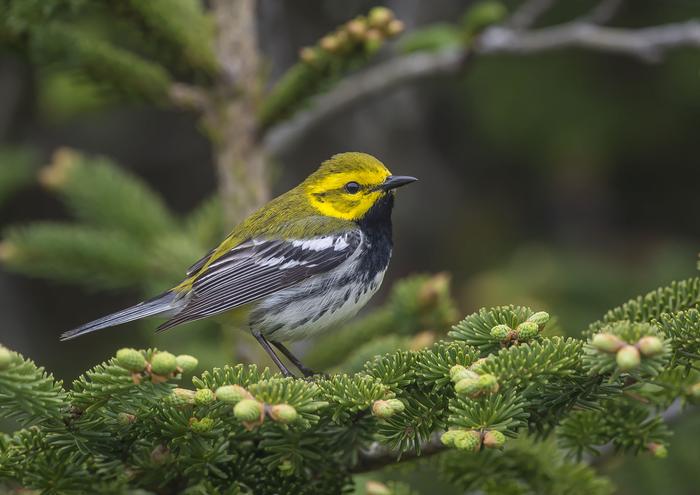
In the expansive and intricate world of ecology, one enduring question has fascinated scientists for decades: how do ecologically similar species coexist without driving each other to extinction through competition? This question was famously explored in the mid-20th century by Robert MacArthur, whose seminal work on wood warblers provided foundational insights into the mechanisms enabling niche partitioning. Now, nearly seventy years later, a new study led by researchers at Penn State University and the American Bird Conservancy revisits MacArthur’s ideas with cutting-edge methodologies, revealing a far more complex and nuanced picture of coexistence among these small yet ecologically significant songbirds.
MacArthur’s 1958 study proposed that multiple species of wood warblers, which are insectivorous birds living in the same forested habitats, avoid direct competition by foraging in different parts of the same tree. His elegant explanation suggested that spatial segregation within the tree allows these closely related species to exploit distinct feeding niches, partitioning the habitat vertically and radially. This concept has since become a cornerstone in ecological theory, often cited in textbooks to illustrate niche differentiation and species coexistence. However, MacArthur’s conclusions were drawn using the best available tools of his time, which lacked the molecular precision and extensive behavioral data collection possible today.
The recent investigation employs a multifaceted approach—a blend of molecular analysis, long-term behavioral observation, and morphometric data integration—to reexamine the niche differentiation among thirteen wood warbler species inhabiting the northeastern forests of New York. Over a span of two decades, the research team meticulously documented the birds’ foraging behaviors, capturing variables such as height in the canopy, distance from the trunk, and foliage density during feeding events. Furthermore, leveraging advances in molecular biology, they used fecal meta-barcoding techniques that allow for precise dietary profiling through DNA analysis of ingested prey remains. This powerful combination permits an unprecedented look into how these species partition their habitat and diet, integrating evolutionary history into the framework.
One of the most striking revelations of this comprehensive study is the decoupling of foraging behavior and diet differentiation. While the researchers confirmed that foraging positions and strategies differ noticeably among the warbler species, dietary overlap was much greater than previously hypothesized. The DNA-based diet analysis revealed that these warblers consume thousands of arthropod species, yet the compositions of their diets were remarkably similar, with substantial overlap in prey taxa. This suggests that spatial partitioning in foraging location, rather than dietary specialization, is the principal axis of niche differentiation in these species.
The team also explored the morphological underpinnings of this behavioral differentiation, analyzing physical traits such as wing shape, body size, and limb length. Their findings align with evolutionary principles where morphology both influences and reflects feeding strategies. For instance, smaller warblers with particular body conformations tend to exhibit more hovering behavior, enabling them to exploit food resources on delicate or less accessible foliage, whereas birds possessing longer legs often forage closer to the ground, correlating their form to function in intricate ways shaped over evolutionary timescales.
These insights hint at the evolutionary pressures mediating warbler species divergence, indicating that competition historically sculpted foraging behaviors and morphological traits. Yet, the similarity in diet composition complicates this narrative, implying that diet alone was not the dominant selective force driving species differentiation. Instead, the fine spatial and behavioral segregation in foraging may serve as the critical mechanism allowing these species to coexist by reducing direct interference competition even when vying for overlapping food resources.
The study underscores the dynamic nature of ecological communities and the complexities in interpreting species interactions over both ecological and evolutionary scales. As Eliot Miller of the American Bird Conservancy elaborates, migrations, seasonal resource availability, and conditions in overwintering habitats likely also contribute substantially to shaping foraging behaviors and evolutionary trajectories. Warblers spend significant portions of the year in Central and South America, where interspecific competition and environmental constraints differ dramatically from their breeding grounds, adding layers of complexity to their ecological and evolutionary stories.
Pioneering methods such as fecal meta-barcoding, which allow researchers to non-invasively and accurately determine diet composition, represent transformative advances in ecological research. These tools exposed limitations in earlier approaches, such as examining stomach contents that often biased toward indigestible fragments, thereby providing only partial glimpses of actual diet. Modern molecular techniques thus enable quantification of dietary breadth and overlap with a precision unattainable in the past, enriching our understanding of resource use patterns and interspecies relationships.
The implications of this research extend beyond theoretical ecology into conservation biology and ecosystem management. By elucidating the nuanced ways in which closely related species partition habitat and resources, scientists and conservationists can better anticipate the effects of environmental change, habitat fragmentation, and species introductions on community dynamics. Understanding that diet differentiation is less pronounced than spatial foraging variation encourages a broader view of habitat conservation priorities, emphasizing structural habitat features across vertical and horizontal scales.
Looking ahead, the research team intends to deepen this inquiry by investigating warbler foraging and diet behaviors during their overwintering period. This future work aims to combine nutritional analyses with ecological observations to determine if competition for higher-quality food sources influences behavior and morphology in ways not fully apparent during the breeding season. The migratory lifestyle of wood warblers, spanning continents and seasons, suggests that their ecological niches are multilayered and influenced by geographic contexts far beyond their breeding trees.
This new study not only honors Robert MacArthur’s pioneering legacy but also exemplifies how modern interdisciplinary methods can both reaffirm and refine classical ecological theories. It demonstrates that niche partitioning, while fundamentally valid as a model, encompasses a richer mosaic of behavioral, morphological, and evolutionary dynamics than previously appreciated. In doing so, it bridges historical ecological inquiry with contemporary technological innovation, inviting a reevaluation of how species interactions are studied and interpreted within complex natural communities.
For backyard bird watchers, the visible skirmishes and interactions witnessed among birds at feeders echo these intricate evolutionary and ecological processes, playing out quietly but profoundly over millennia. Competitive behaviors, subtle differences in foraging strategies, and species-specific adaptations reflect deep evolutionary histories that shape biodiversity and community structure today. Such investigations reveal the extraordinary complexity underlying seemingly simple natural phenomena and remind us of the intricate interconnectedness within ecosystems.
In summary, this comprehensive reassessment of MacArthur’s warblers leverages long-term behavioral data, molecular diet analyses, and morpho-evolutionary frameworks to depict coexistence as a multifaceted ecological phenomenon. It challenges traditional assumptions about diet-driven niche differentiation, highlighting the critical role of spatial foraging segregation and evolutionary history while opening new avenues for research into migratory species ecology and adaptive evolution. The study sets a new benchmark for ecological research, reminding us that even classic models must evolve alongside scientific advances to accurately reflect nature’s complexity.
Subject of Research: Animals
Article Title: Reassessing niche partitioning in MacArthur’s warblers: foraging behaviour, morphology and diet differentiation in a phylogenetic context
News Publication Date: 16-Apr-2025
Web References:
https://doi.org/10.1098/rsbl.2025.0001
Image Credits: Ronnie d’Entremont
Keywords: Species competition, Wild birds, Modern birds, Foraging behavior, Animal research, Diets, Evolutionary developmental biology, Food resources, Foraging, Species interaction, Ecology
Tags: advanced methodologies in ecological researchbehavioral ecology of songbirdsconservation of songbird speciesecological coexistence among birdsecological theories of species interactionshabitat sharing among similar speciesinsectivorous bird feeding strategiesniche partitioning in ecologyPenn State University bird researchRobert MacArthur wood warblers studyspecies competition and survivalvertical habitat utilization by birds


